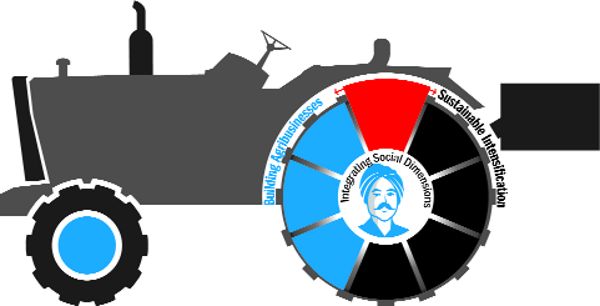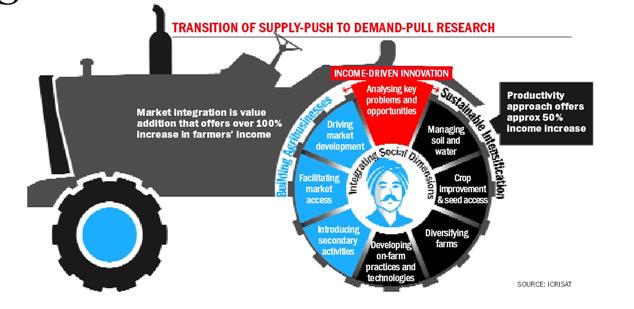
Agriculture Minister Narendra Singh Tomar recently informed Parliament that the Department of Agriculture & Farmers’ Welfare (DoAFW) was going to create a National Farmers Database or ‘Agristack’, a collection of technologies and digital databases focusing on India’s farmers and the agricultural sector.
Manjit S Kang
Agriculture Minister Narendra Singh Tomar recently informed Parliament that the Department of Agriculture & Farmers’ Welfare (DoAFW) was going to create a National Farmers Database or ‘Agristack’, a collection of technologies and digital databases focusing on India’s farmers and the agricultural sector. The database, which will include farmers’ digitised land records, is purported to help offer proactive and personalised services to farmers, increase their income and improve the efficiency of the agriculture sector. The Central Government had formed the Committee on Doubling Farmers’ Income in 2016; it submitted its 14-volume report in 2018. The creation of a dynamic farmers’ database is mentioned in one of the volumes.
 The DoAFW had floated the India Digital Ecosystem of Agriculture (IDEA), which was to seek feedback from parties concerned. Now, ‘Proofs of Concept’ (PoCs) based on data from the federated farmers’ database for certain chosen areas have been invited. If any of the PoCs (pilot) turns out to be beneficial for the farmers, the database is expected to be scaled up to the national level.
The DoAFW had floated the India Digital Ecosystem of Agriculture (IDEA), which was to seek feedback from parties concerned. Now, ‘Proofs of Concept’ (PoCs) based on data from the federated farmers’ database for certain chosen areas have been invited. If any of the PoCs (pilot) turns out to be beneficial for the farmers, the database is expected to be scaled up to the national level.
Farmers and some farm organisations have raised objections to IDEA, as there is lack of farmer representation in the existing task force. They are equating this process to the way the three farm laws were introduced last year, with farmers not being consulted. A proactive approach is always better than a reactive one.
Another objection is regarding the linking of the financing of the states by the Central Government to the implementation of the project. There are other concerns as well; for example, privacy of the farmers’ personal details in the database.
The DoAFW should consider the digital divide between rural and urban areas. According to a survey conducted by the National Sample Survey Office (NSSO), between July 2017 and June 2018, just 4.4% rural households had a computer against 14.4% in an urban area. Only 14.9% rural households had access to the Internet against 42% households in urban areas. Not all farmers have a smartphone. Thus, if launched, most farmers will not be able to enjoy the purported benefits of the national database.
Since one of the purposes of the proposed database is to double farmers’ income, I wish to comment on the report prepared by the Committee on Doubling Farmers’ Income (DFI).
Ashok Dilwai, chairman of the committee, introducing the report, wrote on the website of the Department of Agriculture & Farmers’ Welfare: “Dear Citizens, I am happy to share with you the Report of the “Committee on Doubling on (sic) Farmer’s Income” prepared in 14 Volumes… The above volumes may be downloaded for review by all interested stakeholders.
With great optimisation of an Income Revolution for India’s farmers...”
Volume 8 has four sub-volumes. The smallest volume is No. 10 (‘Risk Management in Agriculture’; 124 pages) and the largest is No. 8D (‘Production Enhancement through Productivity Gains’; 333 pages). Altogether, the 14 volumes have 3,156 single-spaced pages. The biggest stakeholders are the farmers. How can anyone expect farmers to read and digest information from 3,156 pages full of bureaucratic jargon? Let alone farmers, I doubt if many agricultural scientists and policy-makers have read all these volumes.
In Volume 12 (‘Science for Doubling Farmers’ Income’), the committee stated, “At the national level, the priority areas to target doubling of farmers’ income, though Science and Technology could be:
a. Farmers’ database — as recommended in Volume 13, to build a dynamic database and ensure targeted and efficient delivery of support to farmers, and to assist specialised extension services.
b. Credit availability — to provide greater coverage under Kisan Credit Cards, including crops, fishers and livestock farmers, and universal access to post-harvest pledge loans.
c. Market efficiency — to provide market intelligence through demand & price forecasting.
d. Extension system — to standardise information, integration of effort among stakeholders and maximise coverage to reach all farmers.
e. Resource use efficiency — specifically to improve soil and water management.
f. Sustainability and productivity gains — to improve yields and broad-base the production while suiting regional ecological strengths.”
The intriguing phrase in the above statement is “could be,” indicating that the committee was not certain whether the six priority areas they listed would do the miracle of doubling farmers’ income by 2022. How can such a programme succeed when the committee was so tentative in proposing the six priority areas?
The committee listed the following five as essential ‘pillars’ for doubling farmers’ income and sustaining a steady income growth in the long run: increasing productivity as a route to higher production; reduced cost of production/cultivation; optimal monetisation of the produce; sustainable production technology; risk negotiation all along the agricultural value chain. You don’t need a committee to come up with such obvious interventions.
Agricultural scientists have continually pointed out that crop productivity has reached a plateau for various reasons, especially in the food-bowl states of Punjab, Haryana and western UP, where, encouraged by governmental policies, the rice-wheat monoculture has been prevalent for the past 50 years. While costs of agricultural inputs have been increasing significantly year after year, farmers have been getting only incremental increases in the minimum support price (MSP) for the two crops. The Swaminathan Commission made a modest recommendation of providing MSP of 50% over and above the total input costs incurred by the farmer. This has not been done. In addition, sorely needed crop diversification has remained elusive despite the fact that the water aquifers in the food-bowl states are running dry because of the rice-wheat monoculture.
Merely the creation of a national database is not going to double or enhance farmers’ income. Here are some suggestions to enhance their income:
- Incentivise farmers to diversify away from the rice-wheat monoculture toward high-value crops
- Provide accurate weather forecast
- Make available ‘weather-based crop insurance’, whereby farmers are compensated on the basis of unfavourable weather conditions (extreme temperature, floods, drought, hailstorm)
- Incentivise farmers to form Farmer-Producer Organisation (FPO)-type of cooperatives.
- Purchase crops other than rice and wheat at MSP
- Help farmers enhance their ‘staying power’ so that they won’t have to sell their produce all at once
- Prepare agriculture for unpredictable climate change
- Incentivise farmers not to burn paddy straw in the field
- Implement Swaminathan Commission’s recommendations regarding MSP.
The author is former VC, PAU, Ludhiana, and Adjunct Professor, Kansas State University
Send your feedback to [email protected]
Join Whatsapp Channel of The Tribune for latest updates.



























